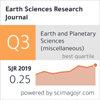小麦生理性状在标准和生态农业系统中的响应
IF 0.5
4区 地球科学
Q4 GEOSCIENCES, MULTIDISCIPLINARY
引用次数: 0
摘要
李建平,李建平,李建平,等。(2020)。小麦生理性状在标准和生态农业系统中的响应地球科学研究,25(1),131-136。本研究于2014-2015年和2015-2016年作物季期间在伊朗西阿塞拜疆省Piranshahr的Payam-e-Noor大学的一个农场进行,目的是调查小麦生理性状对标准和生态农业系统的响应。试验采用双因素、3个重复的裂区设计。第一个因子被认为是主要地块,包括高、低投入和生态农业系统。子图为种子预处理,包括对照(未启动)、水启动和抗坏血酸食品启动。结果表明:最低的光合速率和中温导度与低投入农业系统有关;而在生态系统中,蒸腾、气孔下二氧化碳和光合作用的水分利用效率最低。同时,种子激发提高了光合速率、中温电导率和光合作用的水分利用效率。小麦生理性状在标准和生态农业系统中的响应本文章由计算机程序翻译,如有差异,请以英文原文为准。
Wheat physiological traits response in standard and ecological agricultural systems
How to cite item Fateh, H., Toube, A., & Gholipuri, A. Q. (2020). Wheat physiological traits response in standard and ecological agricultural systems. Earth Sciences Research Journal, 25(1), 131-136. DOI: https://doi.org/10.15446/esrj.v25n1.94403 This research was conducted on a farm of Payam-e-Noor University in Piranshahr, in West Azerbaijan province of Iran, during 2014-2015 and 2015-2016 crop sessions to investigate the wheat physiological traits response to standard and ecological agricultural systems. The experiment was conducted as a split-plot design with two factors and three replications. The first factor, which was considered the main plot, included high, low-input, and ecological agricultural systems. Subplots were seed pre-treatment, including control (without priming), hydro priming, and food priming with ascorbate. The results showed that the least photosynthesis rate and mesophilic conductance were related to lowinput agricultural system; however, in the ecological system, the transpiration, substomatal carbon dioxide, and water use efficiency of photosynthesis were the lowest. Also, seed priming increased the photosynthesis rate, mesophilic conductivity, and water use efficiency of photosynthesis. ABSTRACT Wheat physiological traits response in standard and ecological agricultural systems
求助全文
通过发布文献求助,成功后即可免费获取论文全文。
去求助
来源期刊

Earth Sciences Research Journal
地学-地球科学综合
CiteScore
1.50
自引率
0.00%
发文量
0
审稿时长
>12 weeks
期刊介绍:
ESRJ publishes the results from technical and scientific research on various disciplines of Earth Sciences and its interactions with several engineering applications.
Works will only be considered if not previously published anywhere else. Manuscripts must contain information derived from scientific research projects or technical developments. The ideas expressed by publishing in ESRJ are the sole responsibility of the authors.
We gladly consider manuscripts in the following subject areas:
-Geophysics: Seismology, Seismic Prospecting, Gravimetric, Magnetic and Electrical methods.
-Geology: Volcanology, Tectonics, Neotectonics, Geomorphology, Geochemistry, Geothermal Energy, ---Glaciology, Ore Geology, Environmental Geology, Geological Hazards.
-Geodesy: Geodynamics, GPS measurements applied to geological and geophysical problems.
-Basic Sciences and Computer Science applied to Geology and Geophysics.
-Meteorology and Atmospheric Sciences.
-Oceanography.
-Planetary Sciences.
-Engineering: Earthquake Engineering and Seismology Engineering, Geological Engineering, Geotechnics.
 求助内容:
求助内容: 应助结果提醒方式:
应助结果提醒方式:


